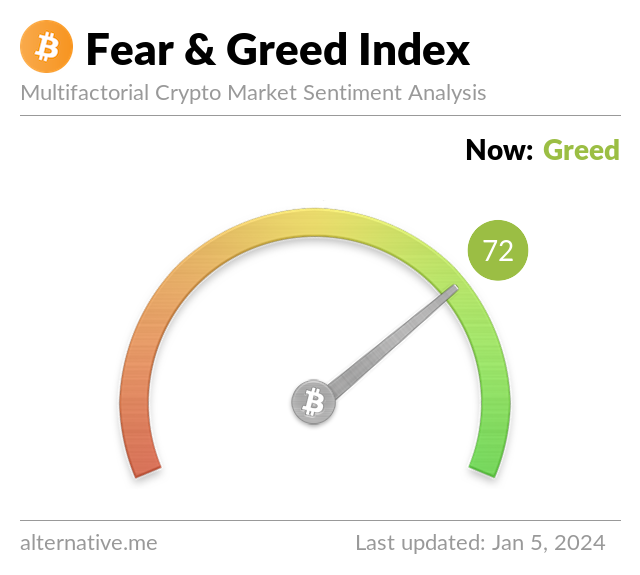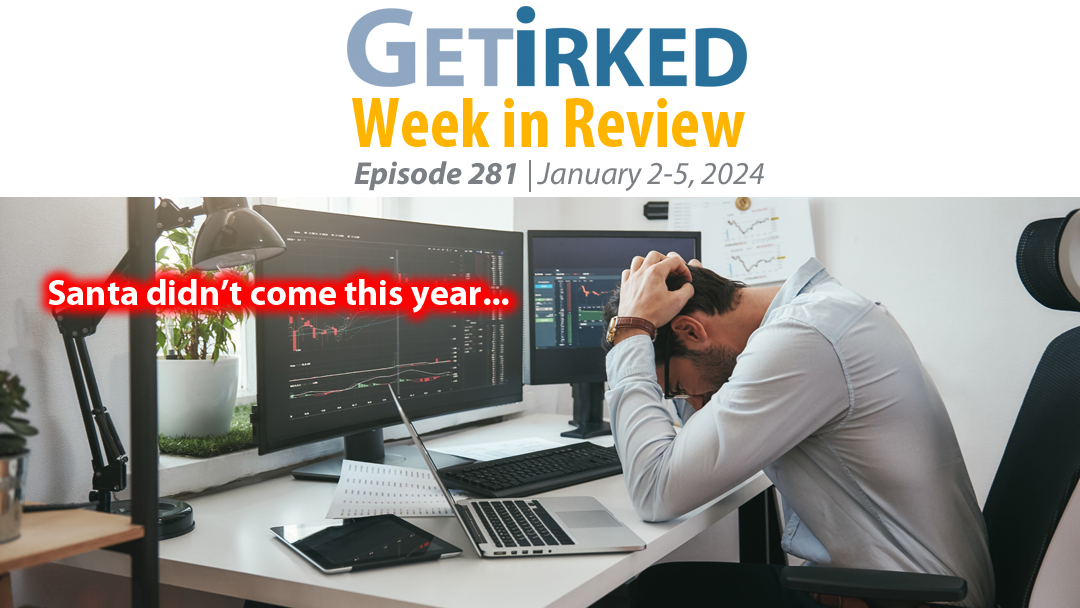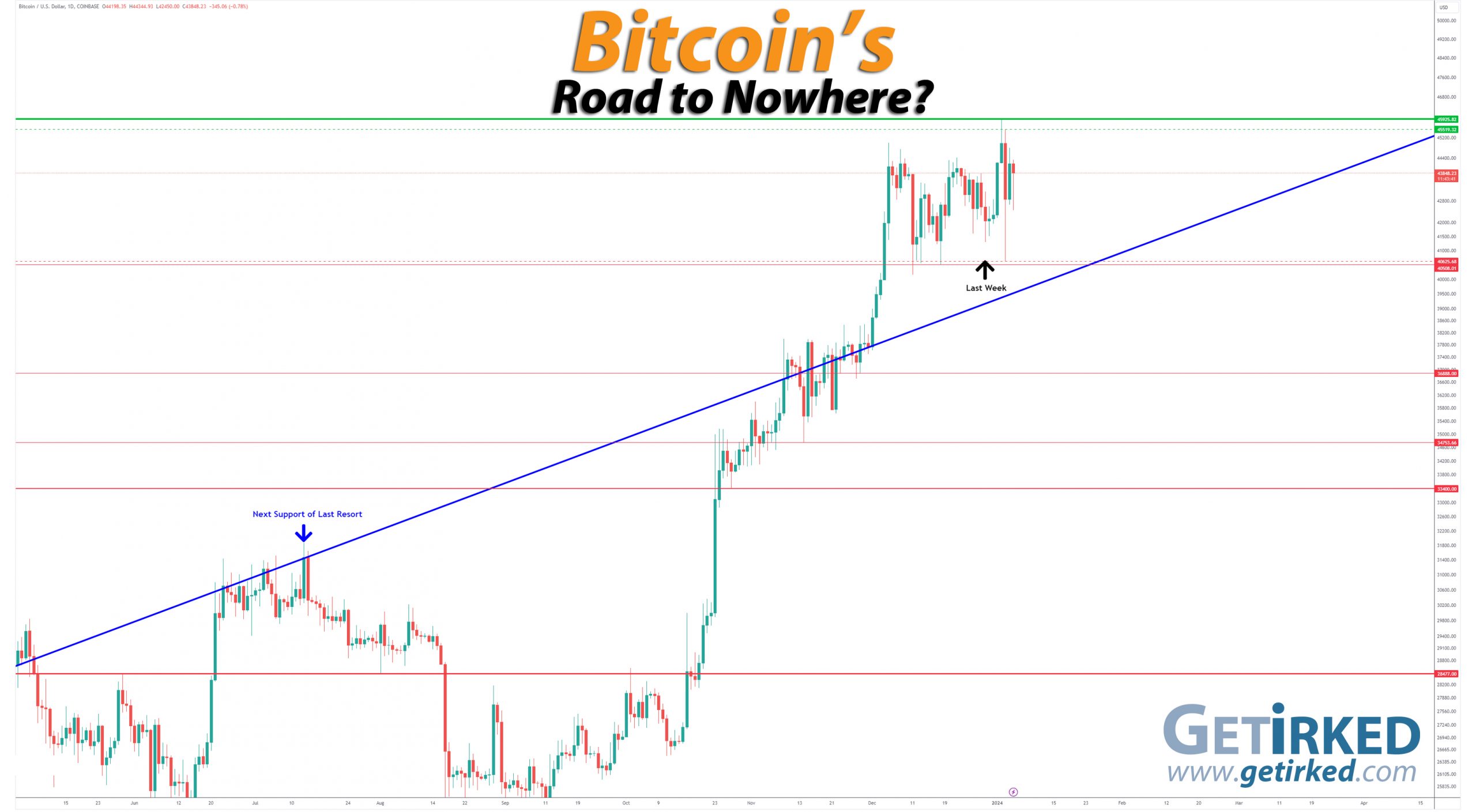Summing Up The Week
It didn’t take a genius to know that the beginning of the year would be weak as institutions and professionals took profits from last year which they didn’t want to create tax events at the end of 2023.
I know this because I’m proof of the fact as I was warning last week that I expected profit-taking to cause a pullback in the markets this week which was exactly what happened.
Despite generally positive news catalysts or, should I say, not negative news catalysts, the Bulls weren’t able to pull the indexes up from being weak for the majority of the holiday-shortened first trading week of the year.
Let’s take a look at the news that moved (or didn’t) the markets this week…
Market News
Job Openings come in slightly lower than expected
On Wednesday, the Job Openings and Labor Turnover Survey (JOLTS) showed job listings of 8.79 million versus the Dow Jones estimate for 8.8 million in November, reported CNBC. Such a slight miss in the report was not the cause for the selling, as it’s likely the moves were a result of seasonal profit-taking after such an excellent 2023 (at least initially).
In general, pundits viewed the JOLTS figures as a positive sign that the Federal Reserve’s efforts to achieve a soft landing have been working. “Today’s JOLTS data is another signal that the Fed is delivering a soft landing,” said Ron Temple, chief market strategist at Lazard. “Today’s report is good news for American workers and the economy, but it also suggests to me that the Fed is unlikely to cut rates as aggressively in 2024, as markets currently indicate, given the risk of reigniting inflationary pressures.”
Fed minutes show likely rate cuts, but the question is “when?”
On Wednesday afternoon, the minutes from the Federal Reserve’s December meeting were released. Rate cuts were deemed likely by the Fed, however there was a great deal of uncertainty regarding when they should engage cuts, reported CNBC. The markets continued to sell off into the close on Wednesday, however, just like the JOLTS data, it’s still likely this sell off was seasonal profit-taking.
As for the uncertainty regarding rate hikes, the meeting minutes contained a lot on the topic. “In discussing the policy outlook, participants viewed the policy rate as likely at or near its peak for this tightening cycle, though they noted that the actual policy path will depend on how the economy evolves,” the minutes noted. “In their submitted projections, almost all participants indicated that, reflecting the improvements in their inflation outlooks, their baseline projections implied that a lower target range for the federal funds rate would be appropriate by the end of 2024.”
The Fed reiterated its determination to remain strongly data-dependent and to not make rash decisions. “Participants generally stressed the importance of maintaining a careful and data-dependent approach to making monetary policy decisions and reaffirmed that it would be appropriate for policy to remain at a restrictive stance for some time until inflation was clearly moving down sustainably toward the Committee’s objective.”
December jobs increased by 216K, much more than expected
On Friday, the Department of Labor’s Nonfarm Payrolls Report for December showed an increase of 216,000 versus the 170,000 expected, reported CNBC. Additionally, the unemployment rate held steady 3.7%, a historically low rate of unemployment particularly in a global economic environment seeing weakness.
The markets were hoping to see a report that came out in-line or even a little cooler than expected to indicate that the Federal Reserve’s attempts to tame inflation were continuing to work. Unfortunately, a hot labor market shows that the companies are not cutting back on spending and the economy is not as soft as the Fed would probably like it to be.
As a result the yield on the 10-year treasury, a key indicator of bullish or bearish sentiment, jumped over 4% once more after languishing around 3.8% for weeks. Accordingly, the selloff which had continued for the first three trading days of 2024 kicked off once more in morning trading on Friday.
Next Week’s Gameplan
Next week sees the first Consumer Price Index (CPI) report of the year which will potentially show additional disinflation taking place which would indicate the Federal Reserve’s plans are working. While there’s always a possibility the CPI report could come in hot, showing a return in inflation, I’m staying aware of the possibility however I don’t feel it’s likely.
Additionally, we’re nearing the Taiwan Presidential Election which will take place a week from Sunday on January 14. The majority of news outlets and the markets themselves seem to think this will be a big nothing burger, and, while I hope that’s the case, the possibility for the outcome to be a catalyst to China making a move against the small nation-state remains out there, but it shouldn’t affect next week’s markets.
At any rate, it’s always exciting to start a new year and to watch which way the markets want to go, at least initially, so I’ll see you back here next Friday with all new data and I’m sure we’ll have stories to share, friends!
This Week in Play
Stay tuned for this week’s episodes of my two portfolios Investments in Play and Speculation in Play coming online later this weekend!
Crytpo Corner

Bitcoin Price (in USD)
%
Weekly Change
Bitcoin Price Action
Bitcoin getting jumpy around its big “ETF Day”
Bitcoin kicked off the week last Friday breaking down to a new weekly low at $41,300.00, before recovering. Then, the action didn’t stop, with Bitcoin rallying through to new highs on Tuesday hitting a new high for the cycle at $45,925.82, only to turn around nearly immediately, and crash through the new weekly low, not finding support until $40,625.68, just a tad above the next key level of support at $40,508.01.
With the answer to where the first spot Bitcoin ETFs just over the horizon, potentially happening as early as next week, we can expect the volatility to continue.
The Bullish Case
Bulls believe the approval of the spot Bitcoin ETFs has not been priced in, and once they are approved, the institutions behind them will start building large positions in order to manage their order flow. Additionally, Bulls argue that the ETFs’ approval will serve as a catalyst to motivate even more new money to flow into the space in the form of retail investors and smaller institutions without their own ETFs.
The Bearish Case
Bears argue that the approval of the spot Bitcoin ETFs has very much priced in and that the approval will be a “sell-the-news” event. Despite being long myself, I have a hard time disagreeing with the Bears on this – the institutions behind the ETFs aren’t dumb so it makes sense for them to already have built up their float positions in Bitcoin long before the ETF approval.
In fact, some Bears argue that the run Bitcoin saw last year from the $20,000 area to $45K+ was just this – institutional buying. If the Bear case proves true, the ETF approval could very much be a big selloff event.
Additionally, from my own experience in Bitcoin, there has never been an approval of a new investment vehicle in the space that was not a sell-the-news event. Both the approval of Bitcoin Futures Trading as well as the Grayscale Bitcoin Trust saw substantial, significant, and painful selloffs in the underlying asset.
Maybe “this time is different,” but wise investors and traders know those are the four most expensive words in the financial world.
Bitcoin Trade Update
Current Allocation: 2.117% (+0.017% since Last Update)
Current Per-Coin Price: $43,383.09 (-0.35% since Last Update)
Current Profit/Loss Status: +1.07% (+2.87% since Last Update)
Bitcoin’s volatility led to a lot of small buying and selling orders getting filled over the past week as the price soared above my cost basis only to crash below it. Net-net, I was left with an increase in allocation of just +0.017% from 2.100% to 2.117%. The combined buys and sells lowered my per-coin cost -0.35% from $43,537.15 to $43,383.09.
Newcomers to the space may find the extreme price volatility jarring, but I’ve learned to harness it and actually enjoy the short periods of time where Bitcoin remains indecisive around my cost basis. I’m offered the opportunity to slowly chip away at my cost basis by both adding and selling as Bitcoin decides where it wants to go next.
Bitcoin Buying Targets
Using Moving Averages and supporting trend-lines as guides, here is my plan for my next ten (10) buying quantities and prices:
0.013% @ $42,511
0.013% @ $41,807
0.013% @ $41,510
0.027% @ $41,221
0.027% @ $40,938
0.027% @ $40,731
0.027% @ $40,524
0.027% @ $40,206
0.027% @ $39,606
0.027% @ $38,675
Not Your Keys, Not Your Crypto…
In light of brokerage failures in 2022, I no longer keep any of my crypto on an exchange and I only keep enough USD on the exchanges I use to execute my next few buys. I use multiple cold wallets from the brands Ledger and Trezor to hold my crypto (click the links to access the direct sites, and I receive no affiliate benefits from these links).
Additionally, I have now divided my allocated USD between two different exchanges – Gemini and Coinbase – in case one (or both) becomes insolvent. Disclaimer: We both receive a bonus if you use either my Gemini or Coinbase referral links to open accounts.
I do not trust anyone in the space, even with Coinbase (COIN) being publicly traded (and one of my own Investments in Play positions).
No price target is unrealistic in the cryptocurrency space – Bullish or Bearish.
While traditional stock market investors and traders may think the price targets in the cryptocurrency space are outlandish due to the incredible spread (possible moves include drops of -90% or more and gains of +1000% or more), Bitcoin has demonstrated that, more than any speculative asset, its price is capable of doing anything.
Here are some of Bitcoin’s price movements over the past couple of years:
- In 2017, Bitcoin rose +2,707% from its January low of $734.64 to make an all-time high of $19,891.99 in December.
- Then, Bitcoin crashed nearly -85% from its high to a December 2018 low of $3128.89.
- In the first half of 2019, Bitcoin rallied +343% to $13,868.44.
- In December, Bitcoin crashed -54% to a low of $6430.00 in December 2019.
- In February 2020, Bitcoin rallied +64% to $10,522.51.
- In March , Bitcoin crashed nearly -63% to a low of $3858.00, mostly in 24 hours.
- Then, Bitcoin rallied +988% to a new all-time high of $41,986.37 in January 2021.
- Later in January 2021, Bitcoin dropped -32% to a low of $28,732.00.
- In February, Bitcoin rallied +103% to a new all-time high of $58,367.00.
- Later in February, Bitcoin dropped -26% to a low of $43,016.00.
- In April , Bitcoin rallied +51% to a new all-time high of $64,896.75.
- In June , Bitcoin crashed -56% to a low of $28,800.00.
- In November, Bitcoin rallied +140% to a new all-time high of $69,000.00.
- In November 2022, Bitcoin crashed -78% to a low of $15,460.00.
- In April 2023, Bitcoin rallied +101% to a high of $31,050.00.
- In June, Bitcoin dropped -20% to a low of $24,750.00
- In July, Bitcoin rallied +29% to a high of $31,862.21.
- In September, Bitcoin dropped -22% to a low of $24,900.00.
- In January 2024, Bitcoin rallied +84% to a high of $45,925.82.
Where will Bitcoin go from here? Truly, anything is possible…
What if Bitcoin’s headed to zero?
The only reason I speculate in the cryptocurrency space is I truly believe Bitcoin isn’t headed to zero. I am prepared for that possibility, however, by knowing I could potentially lose all of the capital I’ve allocated to this speculative investment. Professional advisers recommend speculating with no more than 5% of an investor’s overall assets. Personally, I’ve allocated less than that to speculating in crypto. I feel that anyone who doesn’t fully believe in the long-term viability of cryptocurrency would be better served not speculating in the space. On a good day, this asset class isn’t suitable for those with weak stomachs. On volatile days, the sector can induce nausea in the most iron-willed speculator. If a speculator isn’t confident in the space, the moves will cause mistakes to be made.DISCLAIMER: Anyone considering speculating in the crypto sector should only do so with funds they are prepared to lose completely. All interested individuals should consult a professional financial adviser to see if speculation is right for them. No Get Irked contributor is a financial professional of any kind.


